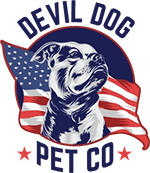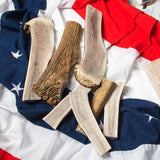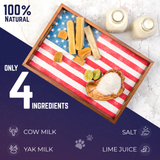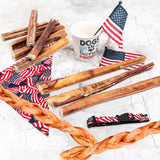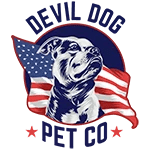Key Takeaways
- Effective leadership is proven when your dog begins to chew aggressively.
- Choosing the right chew toy can prevent damage to your belongings.
- Large Himalayan chews are a disciplined option for tough chewers.
- Providing appropriate chews channels your dog's energy productively.
Table of Contents
- When Jaws Get Serious, Your Leadership Gets Tested
- Natural Chews 101: Why "Natural" Is Non-Negotiable
- The Science & Heritage Behind Himalayan Yak Cheese Chews
- What Makes Himalayan Chews Ideal for Tough, Large Chewers?
- Natural Chews 101: Why "Natural" Is Non-Negotiable
- The Science & Heritage Behind Himalayan Yak Cheese Chews
- Ingredient Integrity & Nutritional Power
- Comparing Chews: Large Himalayan Vs. Everything Else
- Power Chewer Assessment: Is My Dog a Large Himalayan Chew Candidate?
- How-To: Maximizing Value, Safety, and Longevity
When Jaws Get Serious, Your Leadership Gets Tested
The real test of leadership isn't what happens when your dog's lounging peacefully, it's what you hand them when those jaws start working overtime. Will it be a surrender to shredded shoes and demolished furniture, or a disciplined choice that actually delivers results?
If you're dealing with a power chewer, the kind that treats rawhide like tissue paper and makes bully sticks disappear faster than your paycheck, you need more than wishful thinking. You need large Himalayan chews for tough chewers that can go the distance.
Responsible dog owners, especially those commanding large or aggressive chewers, understand this truth: premium, natural chews aren't luxury items, they're mission-critical tools. The difference between a frustrated owner surrendering their dog to a shelter and a confident leader with a well-exercised, mentally satisfied companion often comes down to one thing: giving that dog a job their jaws can actually finish.
This is your Marine-vetted, no-BS Extreme Dog Leadership guide to large Himalayan chews for tough chewers. We're covering everything from the science behind these cheese-based powerhouses to sizing strategies that keep your dog safe and engaged for weeks, not minutes.
Natural Chews 101: Why "Natural" Is Non-Negotiable

What Are Natural Dog Chews?
Natural dog chews come straight from nature, no chemistry lab required. We're talking single-ingredient or minimal-ingredient treats like yak chews, elk antlers, and grass-fed bully sticks. These stand in sharp contrast to synthetic alternatives like chemically-treated rawhide, plastic "bones," and artificially flavored rubber toys.
The core dangers of non-natural chews read like a field manual for what not to do: indigestibility that leads to blockages, chemical residue your dog's liver has to process, and splintering risks that turn chew time into an emergency vet visit. Rawhide, despite its popularity, gets chemically bleached and treated with preservatives that have no business in your dog's digestive system.
What makes a chew worthy of an Extreme Dog Leadership home: It must be fully digestible, free from artificial chemicals, and tough enough to provide genuine mental stimulation without breaking teeth.
Key Benefits of Natural Chews
Natural chews deliver on four fronts that matter to serious dog owners:
- Dental Health: The grinding action scrapes plaque and tartar while stimulating gums, nature's toothbrush that actually works.
- Mental Health: Extended chewing releases endorphins, reducing stress and channeling destructive energy into productive activity.
- Nutritional Value: Quality chews like yak cheese for dogs pack protein, calcium, and minerals that support muscle and bone health.
- Behavioral Benefits: A properly challenged dog stops viewing your furniture as entertainment, directly preventing the behavioral issues that land dogs in shelters.
Here's the bottom line: every minute your dog spends working on a premium natural chew is a minute they're not developing the destructive habits that break the human-dog bond.
The Science & Heritage Behind Himalayan Yak Cheese Chews
What Exactly Are Himalayan Chews?
Authentic Himalayan dog chew products start with a simple recipe that's remained unchanged for centuries: yak and cow milk, lime juice, and a pinch of salt. That's it. No grains, no gluten, no artificial anything, just ingredients that Nepalese villagers have been using to create portable, shelf-stable nutrition for generations.
The process happens in small-village cooperatives high in the Himalayas, where traditional smoking and sun-drying techniques transform liquid milk into rock-hard cheese bars. At Devil Dog Pet Co., we ensure every batch meets Marine standards through rigorous quality control, these aren't just imported treats, they're ethically sourced tools for serious dog owners.
What separates authentic yak chews for dogs from knockoffs is the sourcing transparency and traditional production methods. Cheap imitations skip the smoking process or use industrial drying that creates inconsistent hardness and flavor.
How They're Made: Step-by-Step
The traditional process creates the durability that tough chewers demand:
- Milk Collection: Fresh yak and cow milk gets skimmed to remove excess fat.
- Coagulation: Lime juice curdles the milk, separating protein-rich curds from whey.
- Pressing: Curds get compressed under heavy stones, removing moisture and creating density.
- Smoking: Traditional wood smoke adds flavor while beginning the preservation process.
- Sun-Drying: Weeks of high-altitude drying creates the iron-hard texture that challenges serious chewers.
This slow process matters for three reasons: digestibility improves as lactose drains away with the whey, hardness develops gradually for consistent texture, and shelf life extends naturally without chemical preservatives.
What separates a premium "Monster" yak chew from counterfeits: Authentic large chews maintain uniform hardness throughout, show natural color variation from smoking, and carry the distinctive smoky aroma that dogs find irresistible.
What Makes Himalayan Chews Ideal for Tough, Large Chewers?
 yak cheese, spring water, dog, patriotic flags, and vintage tools.">
yak cheese, spring water, dog, patriotic flags, and vintage tools.">
The texture of properly made yak cheese hits the sweet spot between "impossible to destroy" and "actually chewable." Unlike antlers that can crack teeth or bully sticks that disappear in twenty minutes, large Himalayan chews soften gradually as your dog's saliva works the surface, creating a controlled challenge that lasts.
Durability comparison tells the real story: a Standard bully stick might entertain a 70-pound power chewer for thirty minutes, while a Monster yak chew can provide weeks of engagement when properly sized and rotated. They outlast rawhide by months and offer more flavor motivation than elk antlers, making them the Goldilocks solution for serious chewing needs.
Pros
- Weeks of engagement for power chewers when properly sized
- Fully digestible with minimal mess or odor
- Rich in protein and minerals for nutritional benefit
- Softens gradually to prevent tooth damage
- Lactose-free after traditional processing
Cons
- Higher upfront cost than disposable treats
- Requires proper sizing to prevent choking hazards
- May cause loose stools if consumed too quickly initially
- Not suitable for dogs with severe dairy sensitivities
Natural Chews 101: Why "Natural" Is Non-Negotiable
What Are Natural Dog Chews?
Natural dog chews are single-ingredient or minimally processed treats made from real animal parts or dairy products, no chemicals, artificial preservatives, or synthetic fillers. Think elk antlers, beef pizzle (bully sticks), or yak cheese dried the traditional way.
Synthetic alternatives like rawhide get chemically treated with bleach and formaldehyde. Plastic chew toys offer zero nutrition and can shatter into sharp fragments. Even "natural-flavored" treats often hide corn syrup, artificial colors, and preservatives that have no business in your dog's body.
A truly digestible chew breaks down safely in your dog's stomach like real food. Indigestible options, rawhide, certain bones, synthetic materials, can cause blockages requiring emergency surgery. In our Extreme Dog Leadership philosophy, you choose chews that work with your dog's biology, not against it.
Key Benefits of Natural Chews
Dental Health: Natural chews scrape plaque and tartar while stimulating healthy gums. The mechanical action of gnawing acts like nature's toothbrush, especially important for large breeds prone to dental disease.
Mental Enrichment: A good chew session releases endorphins and burns mental energy. Dogs that chew appropriately are less likely to develop anxiety-driven behaviors like excessive barking or destructive chewing.
Nutritional Value: Quality natural chews deliver protein, calcium, phosphorus, and other minerals. Himalayan yak chews pack dairy proteins and calcium; elk antlers provide trace minerals like zinc and magnesium.
Behavioral Benefits: Proper chewing redirects destructive instincts toward something productive. Dogs surrender to shelters daily because owners couldn't manage chewing behavior, a leadership failure, not a dog problem.
The Science & Heritage Behind Himalayan Yak Cheese Chews

What Exactly Are Himalayan Chews?
Authentic Himalayan chews start with yak and cow milk from high-altitude herds in Nepal. Artisans add lime juice and a pinch of salt, then coagulate the mixture into dense curds. These curds get pressed, slow-smoked over wood fires, and sun-dried for weeks until they achieve that rock-hard texture tough chewers crave.
No grains, no gluten, no artificial anything, just four ingredients following a centuries-old Nepalese tradition. At Devil Dog Pet Co., we source directly from village cooperatives, ensuring every batch meets our Marine-level standards for purity and consistency.
Knockoff "yak chews" flood the market with shortcuts: machine-drying instead of sun-curing, chemical hardeners, or cow-only milk passed off as authentic yak cheese. Real Himalayan chews earn their reputation through time, tradition, and uncompromising ingredient integrity.
How They're Made: Step-by-Step
Step 1: Milk Collection - Fresh yak and cow milk gets skimmed to remove excess fat, concentrating the protein content that creates the chew's dense structure.
Step 2: Coagulation - Lime juice acts as a natural acid, separating milk into solid curds and liquid whey. The curds contain all the protein and calcium your dog needs.
Step 3: Pressing - Heavy stones compress the curds for days, forcing out moisture and creating the dense, uniform texture that prevents splintering.
Step 4: Smoking and Drying - Wood smoke adds flavor while natural air-drying removes nearly all remaining moisture. This dual process creates the shelf-stable hardness that makes large Himalayan chews last weeks instead of hours.
Premium "Monster" and "Beast" sizes require the thickest, most uniform curds, why they cost more but deliver exponentially better value for aggressive chewers.
What Makes Himalayan Chews Ideal for Tough, Large Chewers?
The compressed cheese matrix creates a unique chewing experience: hard enough to challenge powerful jaws, yet gradually softening with saliva to prevent tooth damage. Unlike antlers that stay uniformly hard, yak chews "give" just enough to protect dental health while lasting far longer than softer alternatives.
Size matters for safety and satisfaction. Large, XL, Monster, and Beast sizes prevent gulping while providing the extended chew sessions that mentally exhaust tough chewers. A properly sized Himalayan chew should be longer than your dog's muzzle and thick enough that it can't fit between the back molars.
Pros
- Weeks of chew time for most large dogs
- Virtually odorless and mess-free
- Fully digestible with high protein content
- Softens gradually to protect teeth
- Lactose-free after traditional processing
Cons
- Higher upfront cost than shorter-lasting chews
- May cause initial loose stools from rich dairy proteins
- Not suitable for dogs with severe dairy allergies
- Requires proper sizing to prevent choking
Ingredient Integrity & Nutritional Power
Read the Label Like a Drill Instructor
Quality Himalayan chews list exactly four ingredients: yak milk, cow milk, lime juice, and salt. Period. If you see preservatives, artificial flavors, or chemical hardeners, you're looking at a counterfeit trying to cut corners on the traditional process.
The lime juice isn't there for flavor, it's the natural coagulant that separates curds from whey. Salt acts as a natural preservative during the weeks-long drying process. Both ingredients serve specific functional purposes, not marketing gimmicks.
During the traditional smoking and drying process, nearly all lactose drains away with the whey, making finished chews safe for most dairy-sensitive dogs. The proteins and calcium concentrate into the final product, delivering maximum nutritional value.
Nutritional Analysis
Protein Content: Himalayan chews deliver approximately 60-65% protein by weight, crucial for maintaining muscle mass in active large breeds. This complete protein contains all essential amino acids dogs need for optimal health.
Calcium and Phosphorus: The concentrated dairy minerals support bone density and dental health. Large breeds especially benefit from this natural calcium source during growth phases and senior years.
Calorie Management: A typical Large yak chew contains roughly 300 calories spread across many chew sessions. Factor this into your dog's daily treat allowance, no more than 10% of total calories should come from treats.
Comparing Chews: Large Himalayan Vs. Everything Else
Large Himalayan Chews vs. Bully Sticks
Longevity: A Large Himalayan chew delivers 2-3 weeks of chew sessions for most tough chewers, while even thick bully sticks disappear in 30-60 minutes. The compressed cheese matrix forces slow grinding; beef pizzle gets devoured fast.
Odor and Mess: Himalayan chews stay virtually odorless with minimal debris, maybe a few cheese crumbs. Bully sticks carry that unmistakable barnyard smell and leave greasy residue on carpets and furniture.
Digestibility: Both break down safely in your dog's stomach. Bully sticks deliver pure beef protein; yak chews provide dairy proteins plus calcium and phosphorus. Calorie-wise, a Large yak chew spreads 300 calories across many sessions, while a single bully stick packs 90-210 calories consumed quickly.
Large Himalayan Chews vs. Antlers
Tooth Safety: Antlers stay uniformly rock-hard throughout the chew session, creating higher risk for cracked teeth in aggressive biters. Himalayan chews gradually soften with saliva, providing the "give" that protects dental health while still challenging powerful jaws.
Flavor Drive: Yak cheese delivers immediate taste satisfaction that keeps dogs engaged. Elk antlers offer minimal flavor, relying purely on texture and the satisfaction of gnawing. Dogs with low food motivation often ignore antlers but attack yak chews enthusiastically.
Rotating Strategy: Smart owners use both, antlers for maximum durability when you need hours of quiet chewing, yak chews when your dog needs flavor motivation and digestible nutrition. Dexter gets antlers during our long work calls and yak chews as high-value training rewards.
For more on antler safety and comparison, see are antlers for dogs a good idea.
Large Himalayan Chews vs. Rawhide/Synthetic Chews
This isn't even a fair fight. Rawhide gets chemically treated with bleach, formaldehyde, and other toxins during processing. The leather-like material swells in your dog's stomach, creating blockage risks that send thousands of dogs to emergency surgery annually.
Synthetic chews offer zero nutritional value and can shatter into sharp fragments that damage teeth and intestinal walls. Veterinary emergency rooms see these cases weekly, expensive disasters that proper chew selection prevents entirely.
Himalayan chews dissolve like food because they are food, concentrated dairy proteins your dog's digestive system handles naturally. No chemicals, no blockage risk, no emergency vet bills.
Large Himalayan Chews Advantages
- 2-3 weeks longevity for most tough chewers
- Completely digestible with high protein content
- Virtually odorless and mess-free
- Softens gradually to protect teeth
- Rich in calcium and phosphorus for bone health
Considerations
- Higher upfront cost than quick-consumption chews
- Rich dairy proteins may cause initial loose stools
- Requires proper sizing to prevent choking hazards
- Not suitable for severe dairy allergies
Large vs. Small Himalayan Chews
Size selection isn't about saving money, it's about safety and satisfaction. Small yak chews create choking hazards for powerful jaws and disappear too quickly to provide meaningful enrichment. Large, XL, Monster, and Beast sizes force proper chewing technique and deliver the extended sessions that mentally exhaust tough chewers.
A 70-pound dog that demolishes a Small yak chew in 20 minutes gets zero behavioral benefit and faces potential choking risk. That same dog working on a properly sized Monster chew for weeks develops better chewing habits and sustained mental stimulation.
Power Chewer Assessment: Is My Dog a Large Himalayan Chew Candidate?
How to Identify a True Tough Chewer
Real power chewers destroy "indestructible" toys within hours, splinter wooden furniture, and treat rawhide like potato chips. They chew with focused intensity, not just nibbling or licking, but applying serious jaw pressure with grinding motions.
Signs your dog needs Large Himalayan chews: demolished Kong toys, furniture damage, bully sticks consumed in under 30 minutes, or constant searching for inappropriate chew targets. These dogs aren't "bad", they're under-stimulated and need appropriate outlets for their natural drive.
Dexter taught us this lesson early. Standard chews lasted minutes, leaving him frustrated and us cleaning up shredded couch cushions. Large yak chews finally gave him the challenge and duration his powerful jaws craved.
Safety Tips for Powerful Jaws
Aggressive chewers require extra vigilance. Always supervise initial sessions to observe chewing style, side gnawing is safe, straight-down crunching risks tooth damage. Size up aggressively; what seems "too big" for your dog's weight is often perfect for their jaw strength and safety.
Monitor the chew's condition daily. Retire any piece that develops sharp edges, deep cracks, or becomes small enough to swallow whole. The goal is sustained, safe chewing, not speed consumption.
How-To: Maximizing Value, Safety, and Longevity
Introducing a Large Himalayan Chew to a Tough Chewer
Start with a "chew introduction ritual." Hold one end of the yak chew while your dog investigates and begins gnawing. This teaches proper positioning and prevents them from trying to swallow large pieces. Praise calm, controlled chewing and redirect any aggressive biting attempts.
Limit initial sessions to 15-20 minutes, then remove the chew to maintain novelty and prevent overconsumption. Dogs that pace their chewing develop better habits and experience fewer digestive upsets from rich dairy proteins.
Supervising Chew Sessions Like a Pro
Active supervision means staying engaged, not just present. Watch for proper side-gnawing technique versus dangerous straight-down crushing. Remove the chew if your dog becomes possessive or tries to break off large chunks.
Use chew holders or puzzle feeders to slow down overly aggressive chewers. These tools force dogs to work around obstacles, extending chew time and improving safety. Rotate chew locations to prevent resource guarding behaviors.
Longevity Hacks
Rotation Strategy: Offer the yak chew for short, supervised sessions and rotate with antlers or bully sticks to keep interest high and prevent overconsumption. Store chews in a cool, dry place between uses to maintain hardness and freshness.
For a deeper dive into healthy, single-ingredient treats, check out single ingredient dog treats: a comprehensive guide to healthy snacking.
Curious about how yak cheese dog chews are made? Read this external resource on how yak cheese dog chews are made.
For more on the science behind Himalayan chews, see this external resource.
Download the FREE 10-Step Dog Prep Guide
Frequently Asked Questions
What do vets recommend for heavy chewers?
Veterinarians often recommend durable, natural chews like large Himalayan yak cheese chews because they provide long-lasting engagement without splintering or causing dental damage. These chews are dense yet digestible, helping to satisfy strong chewing instincts while promoting dental health. Supervision and proper sizing are key to prevent choking or stomach upset.
Are Himalayan dog chews safe for large dogs?
Yes, Himalayan dog chews are safe for large dogs when sized appropriately to prevent swallowing large pieces. Their firm texture withstands powerful jaws, offering a satisfying chew that reduces destructive behavior. Because they soften gradually with saliva and are fully digestible, they minimize digestive risks compared to rawhide or synthetic options.
What is the best chew for aggressive chewers?
The best chew for aggressive chewers combines toughness, safety, and digestibility. Large Himalayan yak chews fit this bill by resisting quick destruction, offering a natural, nutrient-rich option that doesn't splinter. For power chewers, pairing these with large whole antlers provides variety and marathon chewing sessions while protecting teeth from damage.
What is the best chew bone for large dogs?
The top chew 'bone' for large dogs balances durability and safety. Large whole elk antlers and sizeable Himalayan yak chews are prime choices, delivering long-lasting satisfaction without the risk of breaking into sharp shards. These chews promote dental health and mental engagement, especially when owners size up to meet their dog’s jaw strength.
What is the toughest chew toy for a dog?
The toughest chew toy for a dog is one that withstands crushing bite forces without splintering or breaking down quickly. Large whole elk antlers are often the hardest natural chews available, offering unmatched longevity and mineral benefits. Himalayan yak chews rank just behind in toughness, providing a fully edible, dense option that handles heavy gnawing while being gentler on teeth.
